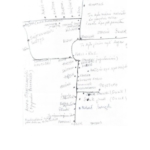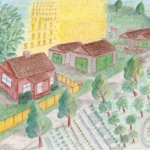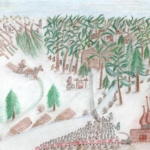 |
Hand drawn map of Stanislawowka |
Stanislawowka no longer exists at all. The village was destroyed by either the Russians or Ukranians. One of the very interesting things about the map is that if you compare it to some pre-war military maps, the two are virtually identical. So Genia Kowalczyk, who drew it, had a very good memory! |
|
|
|
 |
Drawing of Stanislawowka home |
Here are some drawings done by one of the Polish women in Wanda Sawicki's group in London, Ontario Canada. She began drawing in her early seventies, and wanted to draw all of the places in which she had lived: Kresy, Siberia, Africa, England and Canada. Rozalia (Gawor) Wolczyk has given her permission to show them on the Gallery. Rozalia was born in 1925 in Stanislawow, her parents having moved there from Bochnia near Krakow to start a new life. She was deported, along with her family, to Archangielsk, where one of her brothers died. From there, they got to the refugee camp in Pahlevi, moved to Tengeru camp in Africa, then to England where she married and finally to London, Canada. She began English as a second language classes once she retired, then wrote her memoirs with the help of one of her teachers. Called "Always in my Mind." She also took cultural interpreter training and helped us at the London InterCommunity Health Centre as a volunteer in this capacity with the Polish group for several years. She still participates in several programs, and has progressed beautifully in her art work. (Wanda Sawicki.) --- The first drawing is of her family's home in Kresy (Kolonia Stanislawowka, Powiat Sokal, Wojewodztwo Lwowskie), so fondly remembered that the colour of the wheat fields appears to be shining down from heaven as a blessing. |
|
|
|
 |
Drawing of Life in Archangielsk |
Rozalia was deported, to Archangielsk, Siberia. In the upper left, people cut logs under an armed guard. Rozalia, at age 15, is driving some logs by horse through the woods. A woman cooks over an open fire - not soup, but clothing, to get rid of lice. On the right is the cemetery, where one of her brothers was buried. At the bottom, the train arriving, and the people setting out on the 300km, walk to the camp under armed guards. |
|
|
|
 |
Drawing of Tengeru Camp |
The next is Tengeru camp in Africa, a warm paradise. Although they couldn't leave the camp at will (note barbed wire) they could wander over some distance within, even into the jungle to collect fruit. The house of the Englishman in charge of the camp is up high in the centre. |
|
|
|
 |
Drawing of Bower Wood Refugee Camp England |
The camp in England is Bower Wood Polish Refugee Camp, near Beaconsfield, Bucks. It is shown with interesting perspective, with flowers almost as tall as the trees. This kind of perspective was also present in the other drawings, highlighting what was important at the time, in the eyes of a teenager. |
|
|
|
 |
Drawing of home in London, Ontario, Canada |
The final picture, of her house in London, Canada, is seen in real time and perspective, as if the feet are firmly planted on the ground. |
|
|
|







